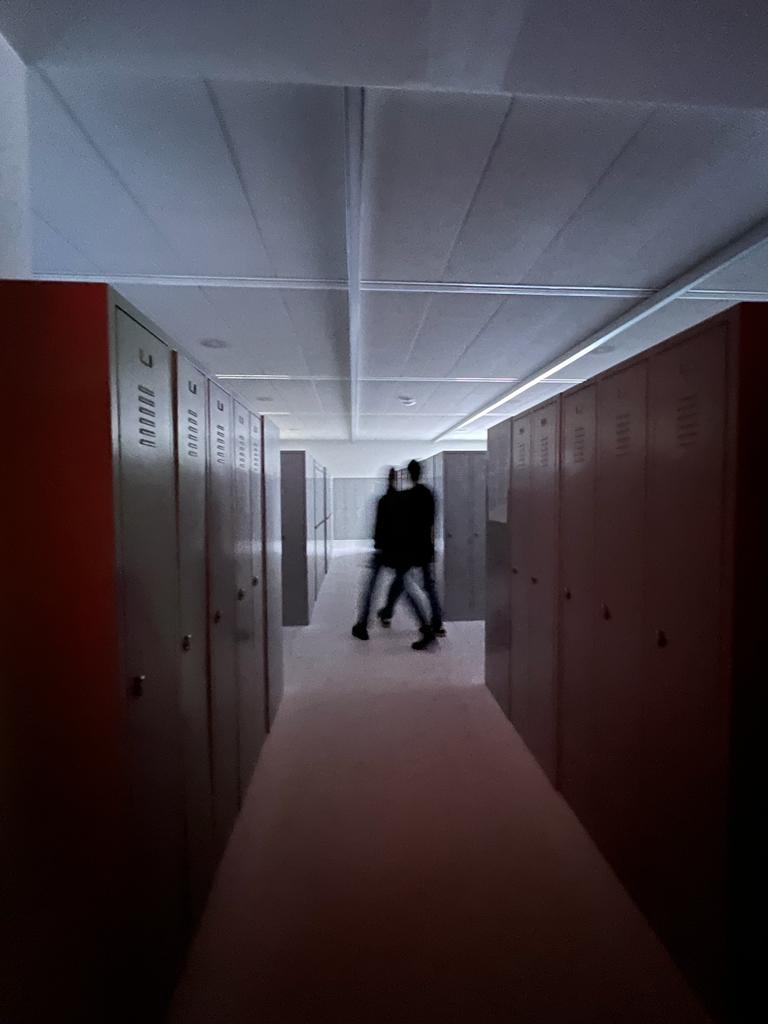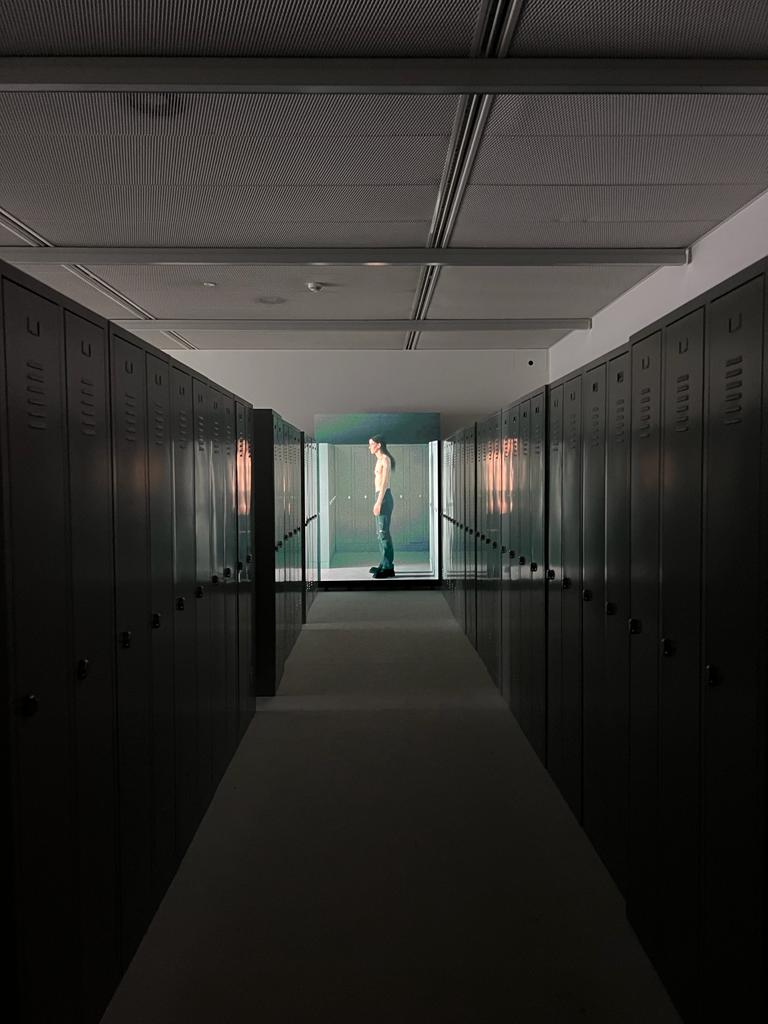
To me, pride is an ever-shifting concept, informed by the values of each new generation. Whereas national pride, for example, might still be salient in the minds of our grandparents and parents, it now appears to have been replaced for many by an appreciation of the social groups we identify with. Still, pride is not an emotional state that I’d immediately associate with our generation. Rather, there seems to be an uncertainty towards whether there is anything left to authentically take pride in.
Unsurprising, given the bulk of our generation seems to be dauntingly pushed towards a chasm of nihilistic apprehension by increasing recognition of societal injustices, the threat of war, an ever-looming climate crisis or merely our mounting insignificance stressed by a world population of eight billion.
Although often turning over these thoughts in my mind, they never became as evident to me as when I visited the YOUTH exhibition by Anne Imhof, currently on display in the Stedelijk Museum until the 29th of January 2023.

© Laura Schnitzer
The German artist who is known for her big-scale installations often relies on performance art and choreography to bring across the stark symbolism of her work. This time she let it unfold in the vast space of the Stedelijk’s 1.100-square-metre lower-level gallery.
One gets seemingly sucked into the exhibition by entering a narrow passage made up of two monotonic rows of grey school lockers. Given their symbolic meaning, the lockers exude reminders of an individual’s interchangeability within a world where our lives are often dictated by the unyielding ideals of institutions.
While branching off into small areas displaying the artist’s former work, the main passage provides the visitor with brief first glances of one of Imhof’s ‘Avatars’: Elisa Douglas staring apathetically into space only wearing a pair of blue jeans and black boots. A few steps down the grey corridor Douglas is again visible on a huge rectangular screen that takes up most of the wall. With unnatural, staccato-like movements she paces down thin paths carved through knee-high snow, leading her along the brick pillars of an industrial ruin. Sometimes she glances at you portraying a lifeless smile. The video’s camera work combined with Douglas’s eery demeanour make one feel as if watching the character of a video game. The Avatar’s constant metamorphism between the bodily and digital sharply points to a world where we’re constantly forced to monitor both our physical as much as our digital selves. The work was shot in a structure nearby the Garage Museum in Moscow where YOUTH was originally meant to exhibit until Russia invaded Ukraine upon which the museum immediately retracted its offer. A fact bringing us back to the reality of our times.

© Laura Schnitzer
The video installation finds its counterpart several metres to its right. There, a huge screen also facing a wider space formed by lockers spells out YOUTH in scarlet letters. The scene gives way to a beautiful, almost kitsch footage of six black horses playfully chasing each other across a snowy plane. The flourishing image of youth and life encompassed in the innocence of nature. The contrast to the alien, lifeless Avatar is almost too apparent. Yet, subtle details unveil it to be an idealistic misconception: The plane seems to be amid urban poverty, surrounded by run-down building blocks with some apartments appearing vacant while others betray signs of life through shabby clothes on washing rods. The horses’ beauty is owed to breeding, estranging them from nature. Like their bodies, their galop in this urban space has been dictated by human desire. A youth trapped, chased from one side of its cage to the other?
For the second part of YOUTH, the exhibition space opens up to a wide hall. In it, a maze of white water tanks and steel constructs is cramped between high ceilings. Its aisles are lined with dark, smoked glass panels covered in graffiti and etched scrawls. Randomly repeating objects like guitars, energy drink cans strewn across mattresses, and a motorcycle helmet speckle the visitor’s path. Above, speakers blaring dysphonic rock music speed along rails which stretch over the length of the ceiling. All seem aimed at creating a dystopian underground world in which different aspects of youth subculture melt into an abandoned warehouse setting. Yet, the clean, unsoiled tanks and the maze’s almost symmetrical patterns fail to truly simulate a dystopian reality making the visitor into a voyeur from the outside, unabsorbed by the portrayed chaos. The maze seems to refer to the disorder of reality without actually being part of it.

Anne Imhof, YOUTH exhibition render. Image from sub (Exhibition Architecture and Supervision)
Despite the abundance of the maze’s different stimuli, walking through it remained a comfortable experience. As if curiously ambling through a vacant theatre set. Having visited the exhibition twice it never revealed itself to me whether this was an effect intended by Imhof. Usually, reports of her exhibitions describe them as disconcerting or even shocking. Considering the promotional work preceding the exhibition and its big-scale format, it would seem quite strange to me had Imhof deliberately envisaged YOUTH to be as timid and mediocrely imposing as I found it to be. Perhaps the exhibition’s true expressive force would have flourished under the Garage Museums’ vast Soviet Modernist architecture in Moscow. Instead, it might have been stifled by the Stedelijk’s orderly calm and the creamy white carpet covering its lower-level gallery.
Nevertheless, to me Imhof’s work ingeniously and candidly describes the emotional state of our generation: The feeling of constantly being trapped in a chokehold of a world faced with existential problems. Problems that are too quiet to jolt us into motion, not real enough to run from, yet exhausting us to the core.
References
– Anne Imhof in Three acts, an improvisation: (2021). Flash Art, 54, 46–65.
– ANNE IMHOF – YOUTH – Hartwig Art Foundation. (n.d.-a). Retrieved January 9, 2023, from https://www.hartwigartfoundation.nl/en/anne-imhof/
– Grrr.nl. (n.d.). Anne Imhof – YOUTH | Stedelijk Museum Amsterdam. https://www.stedelijk.nl/nl/tentoonstellingen/anne-imhof-youth-campagne
– Hohmann, S. (2021, June). Der Tod im Subtext. Monopol Magazin für Kunst und Leben, no 06/2021, 44–60.
– Romack, C. (2021, June 4). Anne Imhof’s Unnerving Hall of Mirrors. The New York Times. Retrieved January 5, 2023, from https://www.nytimes.com/2021/06/02/t-magazine/anne-imhof-exhibition.html
– Sprüth Magers. (2023, January 8). Anne Imhof –. Retrieved January 9, 2023, from https://spruethmagers.com/artists/anne-imhof/
– Turning tides: Anne Imhof at tate modern. (2019, March 26). Spike Art Magazine. Retrieved January 4, 2023, from https://spikeartmagazine.com/?q=articles/turning-tides-anne-imhof-tate-modern
To me, pride is an ever-shifting concept, informed by the values of each new generation. Whereas national pride, for example, might still be salient in the minds of our grandparents and parents, it now appears to have been replaced for many by an appreciation of the social groups we identify with. Still, pride is not an emotional state that I’d immediately associate with our generation. Rather, there seems to be an uncertainty towards whether there is anything left to authentically take pride in.
Unsurprising, given the bulk of our generation seems to be dauntingly pushed towards a chasm of nihilistic apprehension by increasing recognition of societal injustices, the threat of war, an ever-looming climate crisis or merely our mounting insignificance stressed by a world population of eight billion.
Although often turning over these thoughts in my mind, they never became as evident to me as when I visited the YOUTH exhibition by Anne Imhof, currently on display in the Stedelijk Museum until the 29th of January 2023.

© Laura Schnitzer
The German artist who is known for her big-scale installations often relies on performance art and choreography to bring across the stark symbolism of her work. This time she let it unfold in the vast space of the Stedelijk’s 1.100-square-metre lower-level gallery.
One gets seemingly sucked into the exhibition by entering a narrow passage made up of two monotonic rows of grey school lockers. Given their symbolic meaning, the lockers exude reminders of an individual’s interchangeability within a world where our lives are often dictated by the unyielding ideals of institutions.
While branching off into small areas displaying the artist’s former work, the main passage provides the visitor with brief first glances of one of Imhof’s ‘Avatars’: Elisa Douglas staring apathetically into space only wearing a pair of blue jeans and black boots. A few steps down the grey corridor Douglas is again visible on a huge rectangular screen that takes up most of the wall. With unnatural, staccato-like movements she paces down thin paths carved through knee-high snow, leading her along the brick pillars of an industrial ruin. Sometimes she glances at you portraying a lifeless smile. The video’s camera work combined with Douglas’s eery demeanour make one feel as if watching the character of a video game. The Avatar’s constant metamorphism between the bodily and digital sharply points to a world where we’re constantly forced to monitor both our physical as much as our digital selves. The work was shot in a structure nearby the Garage Museum in Moscow where YOUTH was originally meant to exhibit until Russia invaded Ukraine upon which the museum immediately retracted its offer. A fact bringing us back to the reality of our times.

© Laura Schnitzer
The video installation finds its counterpart several metres to its right. There, a huge screen also facing a wider space formed by lockers spells out YOUTH in scarlet letters. The scene gives way to a beautiful, almost kitsch footage of six black horses playfully chasing each other across a snowy plane. The flourishing image of youth and life encompassed in the innocence of nature. The contrast to the alien, lifeless Avatar is almost too apparent. Yet, subtle details unveil it to be an idealistic misconception: The plane seems to be amid urban poverty, surrounded by run-down building blocks with some apartments appearing vacant while others betray signs of life through shabby clothes on washing rods. The horses’ beauty is owed to breeding, estranging them from nature. Like their bodies, their galop in this urban space has been dictated by human desire. A youth trapped, chased from one side of its cage to the other?
For the second part of YOUTH, the exhibition space opens up to a wide hall. In it, a maze of white water tanks and steel constructs is cramped between high ceilings. Its aisles are lined with dark, smoked glass panels covered in graffiti and etched scrawls. Randomly repeating objects like guitars, energy drink cans strewn across mattresses, and a motorcycle helmet speckle the visitor’s path. Above, speakers blaring dysphonic rock music speed along rails which stretch over the length of the ceiling. All seem aimed at creating a dystopian underground world in which different aspects of youth subculture melt into an abandoned warehouse setting. Yet, the clean, unsoiled tanks and the maze’s almost symmetrical patterns fail to truly simulate a dystopian reality making the visitor into a voyeur from the outside, unabsorbed by the portrayed chaos. The maze seems to refer to the disorder of reality without actually being part of it.

Anne Imhof, YOUTH exhibition render. Image from sub (Exhibition Architecture and Supervision)
Despite the abundance of the maze’s different stimuli, walking through it remained a comfortable experience. As if curiously ambling through a vacant theatre set. Having visited the exhibition twice it never revealed itself to me whether this was an effect intended by Imhof. Usually, reports of her exhibitions describe them as disconcerting or even shocking. Considering the promotional work preceding the exhibition and its big-scale format, it would seem quite strange to me had Imhof deliberately envisaged YOUTH to be as timid and mediocrely imposing as I found it to be. Perhaps the exhibition’s true expressive force would have flourished under the Garage Museums’ vast Soviet Modernist architecture in Moscow. Instead, it might have been stifled by the Stedelijk’s orderly calm and the creamy white carpet covering its lower-level gallery.
Nevertheless, to me Imhof’s work ingeniously and candidly describes the emotional state of our generation: The feeling of constantly being trapped in a chokehold of a world faced with existential problems. Problems that are too quiet to jolt us into motion, not real enough to run from, yet exhausting us to the core.


